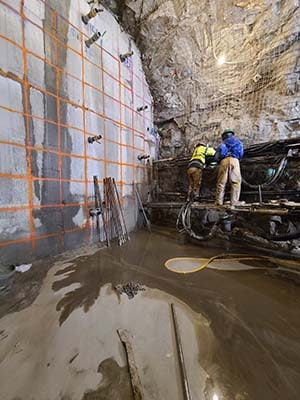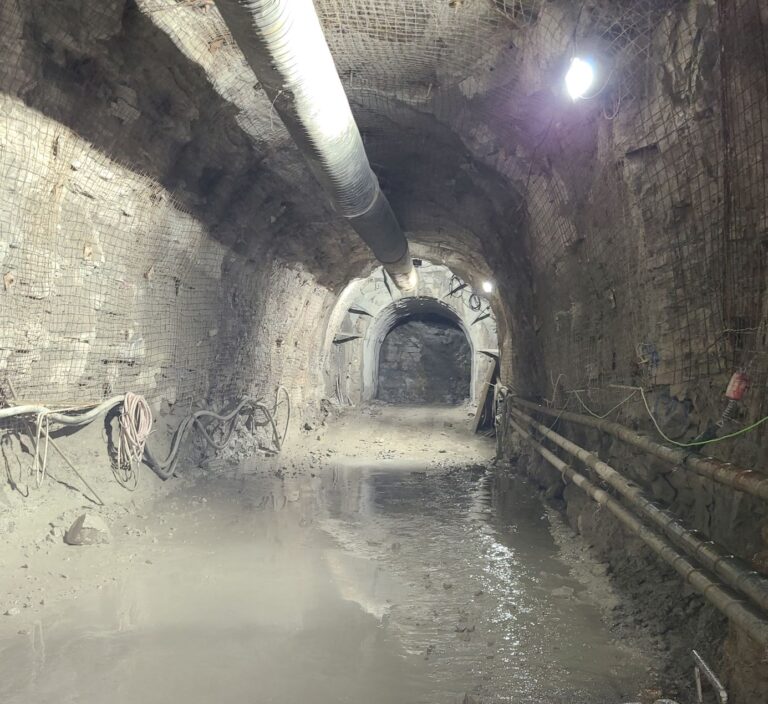By Bill Zietlow, PE
In September 2019, excavation of the Jefferson Barracks tunnel came to a halt when the main beam TBM advanced into an apparent karst feature and encountered flowing sand, gravel and mud. This 11-ft diameter stormwater conveyance tunnel is part of the St. Louis Metropolitan Sewer District ‘s consent decree CSO program. The tunnel parallels the Mississippi River south of St. Louis. Designed to be entirely within good quality, competent limestone bedrock, and below known karst zones, the alignment is approximately 700-ft from and 100-ft below the Mississippi River.
Initial Response Actions
When inflows from the karst void stopped advancement of the open-faced TBM, Affholder (formerly SAK Construction) implemented a grouting program in front of the machine from the ground surface, approximately 200 feet above the tunnel using relatively low-viscosity cement grout. During that initial response, approximately 1,200 CY of grout was pumped through 15 grout holes at elevations from slightly below to slightly above the tunnel alignment. Through this effort. multiple void spaces were discovered in the vicinity of the tunnel face, in addition to the higher elevation karst features that were known prior to tunneling. Encountered voids were variously filled with water, organic mud, or sand and gravel.
Remedy design and execution
Affholder selected a location for the proposed recovery shaft. Concurrently with the surface grouting work, Brierley performed a geotechnical investigation between the proposed shaft and the stalled TBM. The investigation included rock coring and downhole packer testing. Although numerous connected voids were encountered at the tunnel elevation ahead of the TBM, they did not appear to be hydraulically connected to the adjacent Mississippi River.

Based on information gathered during the investigation and conversations with Affholder, Brierley designed a 200-ft deep by 40-ft diameter recovery shaft approximately 200-ft ahead of the TBM, in a location identified by the geotechnical investigation as being likely to have limited or no voids at the tunnel depth and minimal voids above the proposed alignment. Brierley’s design work included shaft support consisting of ring beams and lagging in soil and rock bolts and shotcrete in rock, rock bolts and mesh for initial support in the good rock, and a pipe canopy with steel sets through the karst features that extended 65-ft in front of the stalled machine.
Affholder excavated the recovery shaft to the tunnel elevation and conventionally excavated the recovery tunnel to a point approximately 75-ft ahead of the machine, where additional karst voids were encountered. At this location, a temporary 8-ft thick reinforced concrete bulkhead designed by Brierley was installed to allow probe-hole drilling and high-pressure grouting from inside the recovery tunnel. This resulted in placing 200 CY of low-mobility cement grout to further fill in-situ void space, cut off groundwater, and consolidate loose infill materials. Once the initial grouting through the temporary bulkhead was complete, a double row pipe canopy was installed through the bulkhead. Installation of the inner spile row was carefully logged to document the grouted and un-grouted voids. These voids were mostly infilled with organic clay, although some coarse alluvium was also encountered.
Affholder was prepared to advance sequentially with a partial heading if necessary. However, based on the probing and grout takes at the bulkhead, it was decided to remove the bulkhead and continue carefully with full face drill-and-blast excavation. The final 65-ft of rock in front of the stalled TBM was shot in relatively short rounds with mechanical excavation of the void infill material. Numerous karst features voids, typically four to eight feet across, were encountered along this final reach of the excavation. Some contained grout in addition to the alluvial materials, but very little water was encountered.
In July 2021 Affholder and Brierley Associates celebrated a reverse hole-through when the Jefferson Barracks recovery tunnel was successfully excavated to the face of the stalled TBM. The TBM has been safely exposed, and the pipe canopy and grouting program performed extremely well. The machine was advanced to the recovery shaft and removed for refurbishment. A replacement 13.5ft machine was relaunched out of the same shaft during the 4th quarter of 2021.
The new TBM re-launched in 2021 holed through on Dec. 20, 2022, with no major additional karst zones being encountered. One smaller karst area was encountered after the re-launch but was successfully handled with grouting from inside the tunnel, as designed.


